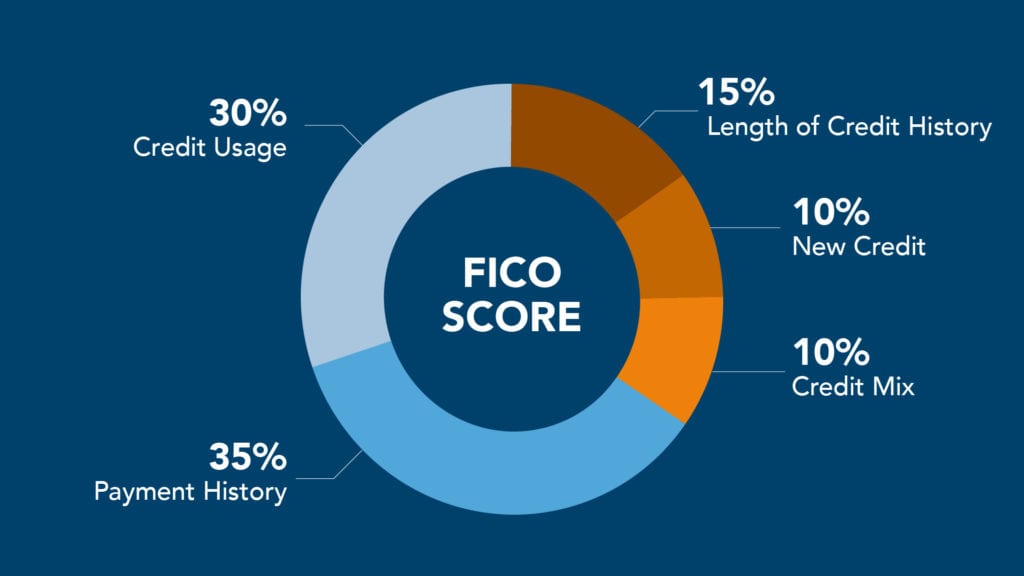Understanding your credit score can be a confusing and often misunderstood topic. Compounding this confusion is the fact that you don't have just one credit score, you actually have a few – and they probably differ by a couple of points at any given time.
Your credit scores are determined by the information contained in your credit report, which is not unlike a grade school report card. But instead of giving you marks for reading and math, your credit report grades your financial wellness. This means that good financial habits like making on-time payments, establishing credit early, and paying your balance in full each month will earn you an A+, er … a higher credit score.
Your credit report is kept by credit bureaus, and there are three big ones to be aware of: Experian, Equifax, and TransUnion. Together, they are responsible for the vast majority of credit decisions in the U.S. When you apply for new credit, banks go to the credit bureaus to get a look at your credit report – including your credit scores – and decide whether or not they're willing to approve your application.
Remember how I said you actually have multiple credit scores? There are two main companies that dominate the credit scoring market, FICO and VantageScore – and both companies use different scoring models for different types of credit decisions.
The FICO Score has been the top dog for nearly 25 years – but that's beginning to change as the three big credit bureaus teamed up to develop the VantageScore 3.0 model. At the end of the day, both FICO and VantageScore consider many of the same factors to generate a three-digit credit score, ranging from 300 to 850.
Here's a look at the different credit score ranges and what they mean.
Although we should all strive for perfection (in terms of credit), there's virtually no difference between someone with a 740 credit score and someone with a perfect 850. That means if you fall into the “excellent credit” category, you'll likely qualify for the lowest interest rates on loans, are more likely to be approved for credit cards, and even get better rates on car and homeowner's insurance.
Factors Impacting Your FICO Score
With the FICO scoring model, the bulk of your credit score is determined by five different categories. The FICO 8 scoring model is the one most commonly used by banks when deciding whether or not to approve a credit card application.
Below, we'll take a closer look at each of the five categories to give you a better understanding of the factors that impact your credit score.
Payment History (35%)
Your payment history is by far the most important factor on your credit report as it makes up 35% of your total score. It is absolutely essential to always pay your bills on time as this will be the biggest factor that can negatively impact your score.
A good best practice is to set up automatic payments with your credit card issuer. This is an easy way to ensure you never forget to make a payment on your credit card bill. This is especially true when you get a new card and aren't already in the habit of checking it on a monthly basis to make your payment.
Credit Utilization (30%)
Your credit utilization is the ratio of your total credit card balance to the total credit limit you have extended to you. For example, if you have one credit card with a credit limit of $10,000 and you are using $1,000 of that limit, your credit utilization would be 10%.
To calculate your utilization rate, add up all of your balances and all of your credit limits and divide the total of your balances by the total of your limits. Keeping your total credit utilization under 30% will have a positive impact on your credit score. The lower your utilization ratio is, the bigger the impact this will have on your score – and since credit utilization makes up 30% of your score, this is an important category to do well in.
Thrifty Tip: Pay off your balances in full each month. This is the easiest way to keep your utilization ratio low and avoid paying interest on credit card debt.
Length Of Credit History (15%)
The longer your credit history, the better as potential lenders will see you as more creditworthy. Your length of credit history is calculated based on the age of your newest account, the age of your oldest account, and the average age of all of your credit accounts. This is not specific to credit cards and will factor in mortgages, auto loans, student loans, etc.
For this reason, it's a good idea to always keep your oldest credit cards open – even if you're no longer using them. Doing so will increase the average age of your credit accounts which will help this portion of your credit score.
Thrifty Tip: If your oldest credit cards charge an annual fee, call your bank and ask to downgrade to a no-annual-fee card instead.
Credit Mix (10%)
Generally speaking, diversifying your open credit accounts will have a positive impact on your score. Having different credit accounts open (auto loans, mortgages, student loans, credit cards) will give your score a nice bump.
But keep in mind that this category only accounts for 10% of your total score. It wouldn't make sense to take out an auto loan or wait to pay off a student loan, just to diversify your credit mix. In fact, paying off outstanding debts, like student loans, will lower your credit utilization and likely have a far greater impact on your overall score.
New Credit (10%)
Won't applying for a new credit card hurt my credit score? This is a question that we get asked time and time again.
The short answer is yes: Applying for a new line of credit will have a small, temporary impact on your overall credit score. However, assuming you are making on-time payments and being responsible with the new line of credit, having more credit available will generally help your utilization ratio.
Long term, your utilization ratio will have a bigger impact on your total credit score than new credit will.
For some reason, this is the portion of your credit score that people worry about most, yet it has the smallest impact.
Read more: 4 Credit Card Myths You Should Stop Believing
Factors Impacting Your VantageScore 3.0
According to Credit Karma, the bulk of your VantageScore is made up of just a handful of factors – three of which carry more weight than the others.
Similar to the FICO scoring model, your VantageScore is weighed heavily by your payment history, credit utilization, and age and type of credit (credit mix). These three factors, alone, make up more than 80% of your total score.
Payment History (40%)
I can't stress this one enough: Paying your bills on time is essential to having a healthy credit score. While one late payment likely isn't enough to tank your score, repeatedly paying your credit card bill late will have a long-term impact and your score and make it harder to get approved for new lines of credit in the future.
Setting up automatic payments – even for the minimum payment amount – is a good way to ensure you don't miss a payment on your account.
Age and Type of Credit (21%)
Establishing credit early in life and maintaining a diverse credit mix is another big factor in determining your VantageScore.
A good way to get started building credit early is to add children to your account as authorized users as soon as possible. Doing so will help them establish a credit history and your good credit behavior will carry over to their credit report when they turn 18.
Credit Utilization (20%)
Borrowing money from the bank whether it be an auto loan, home mortgage, or a credit card is serious business. Ensuring that you're not using up any more of your available credit than absolutely necessary will help keep your credit utilization low and thus improve your credit score.
This is the number one thing that we try to preach anytime we're talking about the big welcome bonuses available on top travel rewards credit cards.
Balances (11%)
Similar to your credit utilization, keeping your balances low will also have a positive impact on your score. The best way to do this is to pay your revolving credit (credit cards) balances in full each month.
Doing so will not only help your credit score but it also means that you'll avoid paying unnecessary interest to the banks.
Recent and Available Credit (8%)
Applying for new credit will have a small, negative, impact on your score. Just like with the FICO scoring model, this is the factor that often gets the most attention when we talk about earning points and miles with travel rewards credit cards, but it actually accounts for the smallest percentage of your score.
How to Get Your Free Credit Score
Now you know all the factors that go into determining your credit score, but how exactly do you go about finding it? The simplest way is through your bank.
If you hold a credit card from just about any bank, they will likely provide weekly or bi-weekly updates to your estimated credit score.
The image below is from my Capital One account, and they are using the VantageScore 3.0 model from TransUnion – one of the three major U.S. credit bureaus.
If you don't have a credit card or just want an easier way to stay on top of your credit, Credit Karma is a fantastic resource. It is a free service that also offers a mobile phone app that helps you monitor your credit score. It'll also give you recommendations about how to improve your score based on what is on your credit report.
Credit Karma provides free VantageScore 3.0 credit scores from both TransUnion and Equifax (Experian is not included). The service will update your score weekly and, if you have the mobile app, will send you a push notification if there are any changes to your report.
It is by far the most efficient and easiest way to stay on top of your credit score. Plus, Credit Karma is using full bank-level encryption to protect the transmission of your personal data on their website. They also do not share your personal information with any unaffiliated third parties.
Tips for Good Credit
- People with the highest credit scores have zero late payments and utilization ratios of less than 10%. Never miss a payment and pay all credit card bills on time.
- Eliminate your credit card debt. You won’t pay interest charges and you will have the maximum credit utilization ratio since you won’t be carrying a balance.
- Keep accounts open for as long as possible. I always recommend keeping 1-2 credit cards with no annual fees to increase the average age of your credit accounts.
- Take advantage of your free annual credit report at AnnualCreditReport.com. You can also monitor your credit for free through platforms like Credit Karma.
- Several credit card issuers such as American Express, Chase, Citi, & Discover provide an estimated credit score for free on monthly statements. You can also access this in your online account at any time.
Bottom Line
Understanding your credit score is an often misunderstood topic. The VantageScore and FICO scoring methods are used in the vast majority of credit decisions and are calculated based on the factors outlined above.
Knowing what goes into your credit score is the first step to establishing a good credit history and setting yourself up for long-term financial success.




